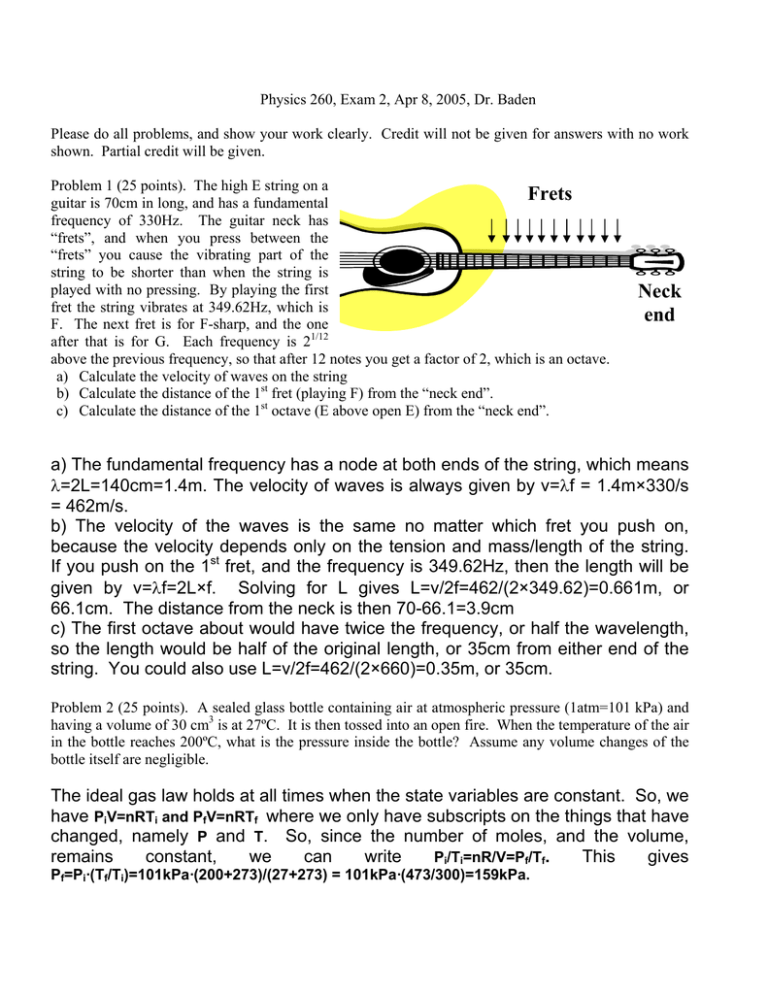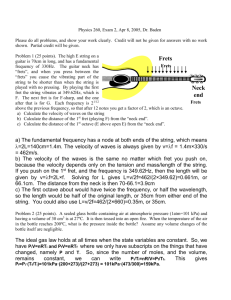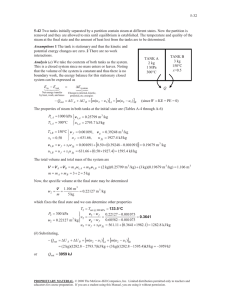Frets Neck end
advertisement

Physics 260, Exam 2, Apr 8, 2005, Dr. Baden Please do all problems, and show your work clearly. Credit will not be given for answers with no work shown. Partial credit will be given. Problem 1 (25 points). The high E string on a Frets guitar is 70cm in long, and has a fundamental frequency of 330Hz. The guitar neck has “frets”, and when you press between the “frets” you cause the vibrating part of the string to be shorter than when the string is played with no pressing. By playing the first fret the string vibrates at 349.62Hz, which is F. The next fret is for F-sharp, and the one after that is for G. Each frequency is 21/12 above the previous frequency, so that after 12 notes you get a factor of 2, which is an octave. a) Calculate the velocity of waves on the string b) Calculate the distance of the 1st fret (playing F) from the “neck end”. c) Calculate the distance of the 1st octave (E above open E) from the “neck end”. Neck end a) The fundamental frequency has a node at both ends of the string, which means λ=2L=140cm=1.4m. The velocity of waves is always given by v=λf = 1.4m×330/s = 462m/s. b) The velocity of the waves is the same no matter which fret you push on, because the velocity depends only on the tension and mass/length of the string. If you push on the 1st fret, and the frequency is 349.62Hz, then the length will be given by v=λf=2L×f. Solving for L gives L=v/2f=462/(2×349.62)=0.661m, or 66.1cm. The distance from the neck is then 70-66.1=3.9cm c) The first octave about would have twice the frequency, or half the wavelength, so the length would be half of the original length, or 35cm from either end of the string. You could also use L=v/2f=462/(2×660)=0.35m, or 35cm. Problem 2 (25 points). A sealed glass bottle containing air at atmospheric pressure (1atm=101 kPa) and having a volume of 30 cm3 is at 27ºC. It is then tossed into an open fire. When the temperature of the air in the bottle reaches 200ºC, what is the pressure inside the bottle? Assume any volume changes of the bottle itself are negligible. The ideal gas law holds at all times when the state variables are constant. So, we have PiV=nRTi and PfV=nRTf where we only have subscripts on the things that have changed, namely P and T. So, since the number of moles, and the volume, remains constant, we can write Pi/Ti=nR/V=Pf/Tf. This gives Pf=Pi·(Tf/Ti)=101kPa·(200+273)/(27+273) = 101kPa·(473/300)=159kPa. Problem 3 (25 points). What mass of steam initially at 130ºC is needed to warm 200g of water in a 100g glass container from 20ºC to 50ºC? (The specific heats of water, ice, and steam, and glass are cw=1 cal/gmºC, cice=.5cal/gmºC, csteam=.48cal/gmºC, cglass=0.2cal/gmºC. The latent heats of vaporization and fusion for H2O are Lv=540cal/gm and Lf=79cal/gm). This is a heat transfer problem where we know the final temperature of the glass and water combination. We have to do is calculate the heat liberated by the steam in going to 50ºC, and that will be a function of the mass of the steam, and equate that with the heat needed to raise the glass and water from 20ºC to 50ºC. Since there might be a phase transition at the water/steam boundary, we have to do this problem in 3 parts: part 1 is cooling the steam, part 2 is condensing, and part 3 is further cooling of the water: 1) Steam cooling from 130ºC to 100ºC: Qout,1 = msteamcsteam·(Tf-Ti) = msteam·0.48(cal/gºC)· (130ºC -100ºC) = msteam·0.48(cal/gºC)·30ºC = msteam·14.4(cal/g) 2) Steam condensing: Qout,2 = msteamLv = msteam·540(cal/g) 3) Water (was steam) cooling from 100ºC to 50ºC: Qout,3= msteamcw·(Tf-Ti)= msteam·1.00(cal/ gºC) ·50ºC= msteam·50 The total heat liberated by the steam is then the sum of the above: Qout = Qout,1+Qout,2+Qout,3=msteam·(14.4+540+50)= msteam·604.4 The heat gained by the water/glass combination going from 20ºC to 50ºC is: Qin = mwcw·(Tf-Ti)+mglasscglass·(Tf-Ti) = (mwcw+mglasscglass)·30ºC = [100g·1.0(cal/gºC)+200·0.2(cal/gºC)]·⋅30ºC = 6600cal These two heats must be equal: Qout = msteam·604.4 = Qin=6600cal, or msteam·604.4=6600cal, giving msteam=6600/604.4=10.9g Problem 4 (25 points). Nine monatomic particles with a mass of 1.3x10-25kg have speeds of 5, 8, 12, 12, 12, 13, 13, 17, and 20 m/s (the Boltzmann constant is 1.38x10-23J/K) . Calculate a) the average velocity b) the rms velocity c) the most likely velocity d) the temperature a) the average is given by vave=(5+8+12+12+12+13+13+17+20)/9=12.7m/s b) the rms average is given by taking the square root of the average v2: (vrms)2≡( (v2)ave=52+82+122+122+122+132+132+172+202)/9=178m2/s2 or vrms=13.3m/s c) the most likely value is 12, since there are 3 of those and no more than 2 of any others. d) The average KE is given by KEave=m·v2ave/2=1.3×10-25kg·178m2/s2=115.7×10-25J and we know that KEave=(3/2)kBT. Therefore the temperature is T=(2/3)KEave/kB=0.67· (115.7×10-25)/(1.38×10-23)=0.6K




